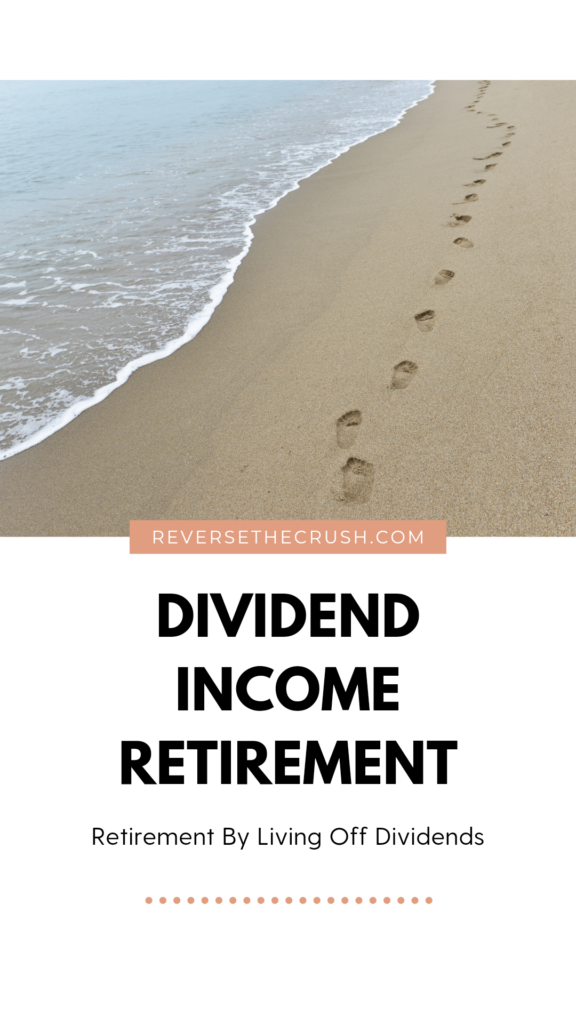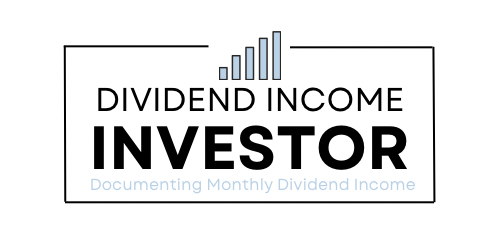Dividend income retirement — retirement by living off the dividend income your stock portfolio generates. Everything you need to know. I am not a licensed investment advisor and this post is not investment advice. This blog is for entertainment purposes only. This article may contain affiliate links.
There are plenty of different ways to retire.
You can work until 65 and then receive government and employer pensions.
Alternatively, you can aggressively invest in index funds until you save up 25 times your annual income. Then, you can live off the growth of your investments by withdrawing 4% per year.
Historically, the portfolio should still grow around 7% per year, so the growth should outpace the amount you withdraw.
But pensions and index funds aren’t the only way to retire. There’s also growth investing and dividend growth investing.
In this post, I’m going to discuss a dividend income retirement — retirement by living off dividends.
Let’s dive in.

What Is A Dividend Income Retirement?
Simply put, a dividend income retirement means you retire by living off the dividend income your stocks generate.
If enough money is invested in quality dividend paying stocks, you can earn enough dividend income to cover your expenses.
Once your portfolio of dividend stocks earns enough dividend income to pay for your expenses, technically, you are financially independent. That’s a dividend income retirement. And it’s the best kind of retirement in my humble opinion.
Benefits Of A Dividend Income Retirement
For a dividend investor such as myself, there is a never-ending list of benefits of a dividend income retirement.
Check out this article on why dividend investing is my main investment strategy.
Mainly, though, you don’t have to sell investments to get paid in retirement. You simply wait for the dividends to roll in and design your own payment schedule.
In addition, dividend investing is a strategy that is easy to stick to. Since your goal is to increase dividend income, you simply buy quality stocks and hold them long term. It’s easy to stick to because you see the progress of your dividend income as you invest.
Another reason to like dividend income investing is that it’s trackable and measurable. It’s easy to compare year-over-year growth to see how fast your dividend income is growing.
Furthermore, dividend income investing is a viable strategy because dividend income growth outpaces inflation. Stocks with high dividend growth rates will outpace inflation, so your income will not be eaten up by inflation. This will happen through dividend raises.
In addition to receiving dividend raises, compound interest will supercharge your wealth if dividends are reinvested over the long term. It might take 5 to 10 years to get going, but compound interest will eventually take over and expand your wealth beyond what you could’ve dreamed.
Finally, dividends provide predictable income to shareholders and retirees.
Risks Of Living Off Dividends
Of course, everything has its share of tradeoffs.
Although living off dividends has many benefits, it is not without risks.
The main concern for retirees who live off dividends is the risk of dividend cuts or slashes. If a company cuts or lowers its dividend payment, a dividend investor’s income is immediately impacted. As such, it’s important to select stocks wisely, and to diversify your portfolio to minimize the impact of dividend cuts.
Additionally, anytime an investor puts capital to work in the market, the money is at risk of a stock market correction or recession. If that happens, you either have to wait for the market to recover, or you have to sell at a loss. Hence why it’s important to manage your portfolio appropriately according to your age.
Also, it should be noted that dividend investing requires the ability to analyze stocks and it can be time consuming. Although dividend income is passive income, investors must be able to select the right stocks and know when to buy and sell.

Can You Really Retire On Dividend Income?
So, is a dividend income retirement really possible?
Yes, absolutely it is.
It just comes down to having enough money invested to receive enough dividend income to cover your expenses.
Through saving a high percentage of your income and investing it in high quality dividend stocks, anyone can reach a dividend income retirement in 10 to 20 years. And it can happen a lot sooner if enough money is saved.
How Much Do I Need In Dividends To Retire?
The amount of dividend income you need to retire depends on your expenses.
To retire, you need enough income to pay for all your expenses.
In my case, I require at least $1,500 per month to cover the cost of my expenses. Ideally, I want at least $2,000 to have extra spending money.
So, to live off dividends, I need at least $1,500 to $2,000 per month in dividend income.
To reach a dividend income retirement sooner, I can either increase my dividend income by saving more money, or I can lower my monthly expenses.
As soon as your dividend income exceeds your annual expenses, you have reached the dividend crossover point. You are essentially financially independent at this point.
How Much Money Do You Need To Invest To Retire With Dividends?
Now you now how much dividend income you need to retire.
I’m sure you are wondering how much money do you need to invest to earn enough dividend income to retire.
Well, if you need around the same as me to retire, you need to invest at least $400,000.
To earn $40,000 from dividends at an average yield of 4.78%, I would need to invest $836,820.08.
Related: How Much Do I Need To Invest To Live Off Dividends?
How Are Dividends Taxed During Retirement?
As the saying goes, there is no free lunch.
And that is the same for dividend investing when it comes to non-registered accounts. If you hold stocks in a non-registered account, you will have to pay a tax on the dividends you receive. The rate of tax will depend on where you reside. You should check with an accountant or licensed tax professional.
However, there are some cases where there is a free lunch with dividend investing.
For instance, Canada offers a tax-free savings account (TFSA), which allows investors to invest in Canadian stocks without incurring any tax at all. There are some limitations on the amount you can invest. But the TFSA is an excellent option for dividend investors to build their dividend income portfolio in.
Alternatively, Canadian investors can invest in a registered retirement savings plan (RRSP). This will allow them to defer income tax on the amount of money they invest, and it would avoid tax on dividends and capital gains. Your dividends would still be taxed as income when you withdraw them, though.
If you are outside of Canada, or for more details on how dividends are taxed, check with a licensed tax advisor or accountant to learn how dividends are taxed.

Dividend Income Retirement — Final Thoughts
In my humble opinion, a dividend income retirement is one of the smoothest ways to retire of all.
Dividend income retirees simply live off the dividends their stocks generate.
This is ideal because it means investors are not forced to sell their investments in retirement.
To retire off dividends, you need to earn enough dividend income to cover your expenses.
If you require $40,000 annually to retire comfortably, you need to invest $836,820.08 at a 4.78% dividend yield.
Moreover, anyone can obtain financial independence through a dividend income retirement by saving a high percentage of their income and investing consistently for 10 to 20 years.
What do you think? Would you rather live off dividends in retirement or sell your investments to cover your expenses? Any better ways to retire that you know of?
Related Articles On Retirement Through Dividend Investing
How Much Do I Need To Invest To Live Off Dividends?
Live Off Dividends — Planning To Live Off Dividends & Blog Full-time
Dividend Investing Tips — 9 Must-Know Tips For Dividend Investors
I am not a licensed investment or tax adviser. All opinions are my own. This post may contain advertisements by Monumetric and Google Adsense. This post may also contains internal links, affiliate links to BizBudding, Amazon, Bluehost, and Questrade, links to trusted external sites, and links to RTC social media accounts.
Connect with RTC
Twitter: @Reversethecrush
Pinterest: @reversethecrushblog
Instagram: @reversethecrush_
Facebook: @reversethecrushblog
Email: graham@reversethecrush.com


 Financial Moves To Make In Your 30s
Financial Moves To Make In Your 30s
